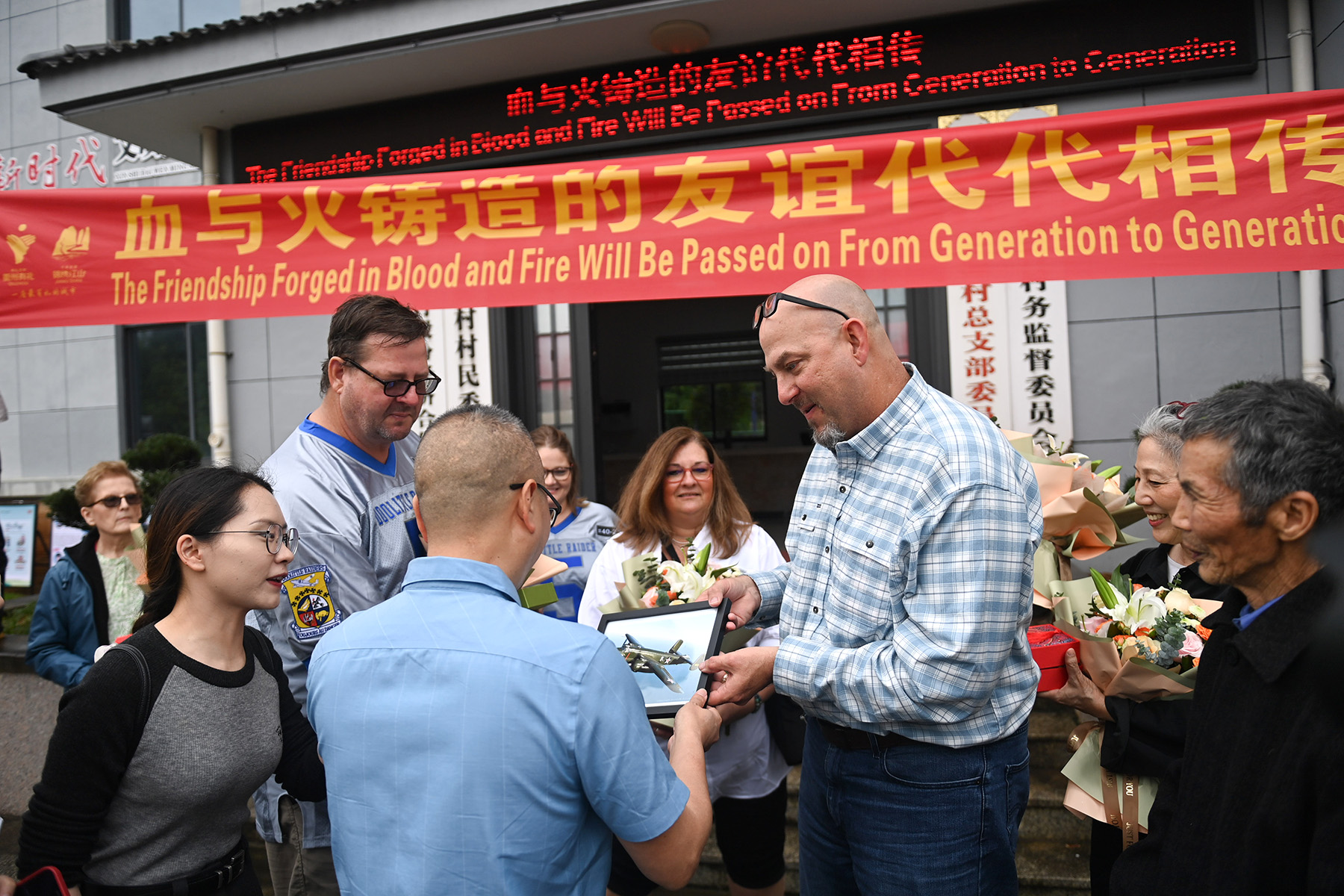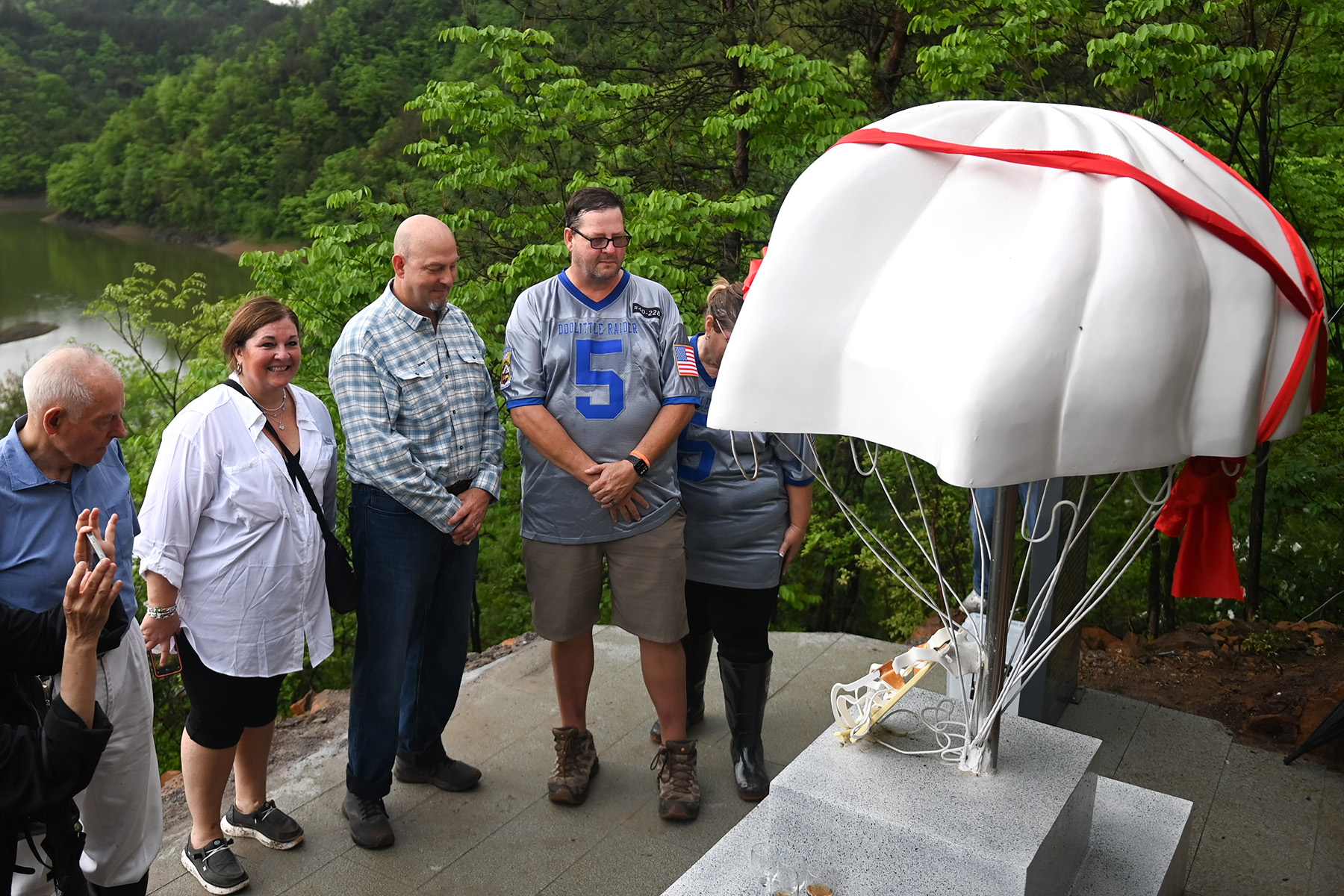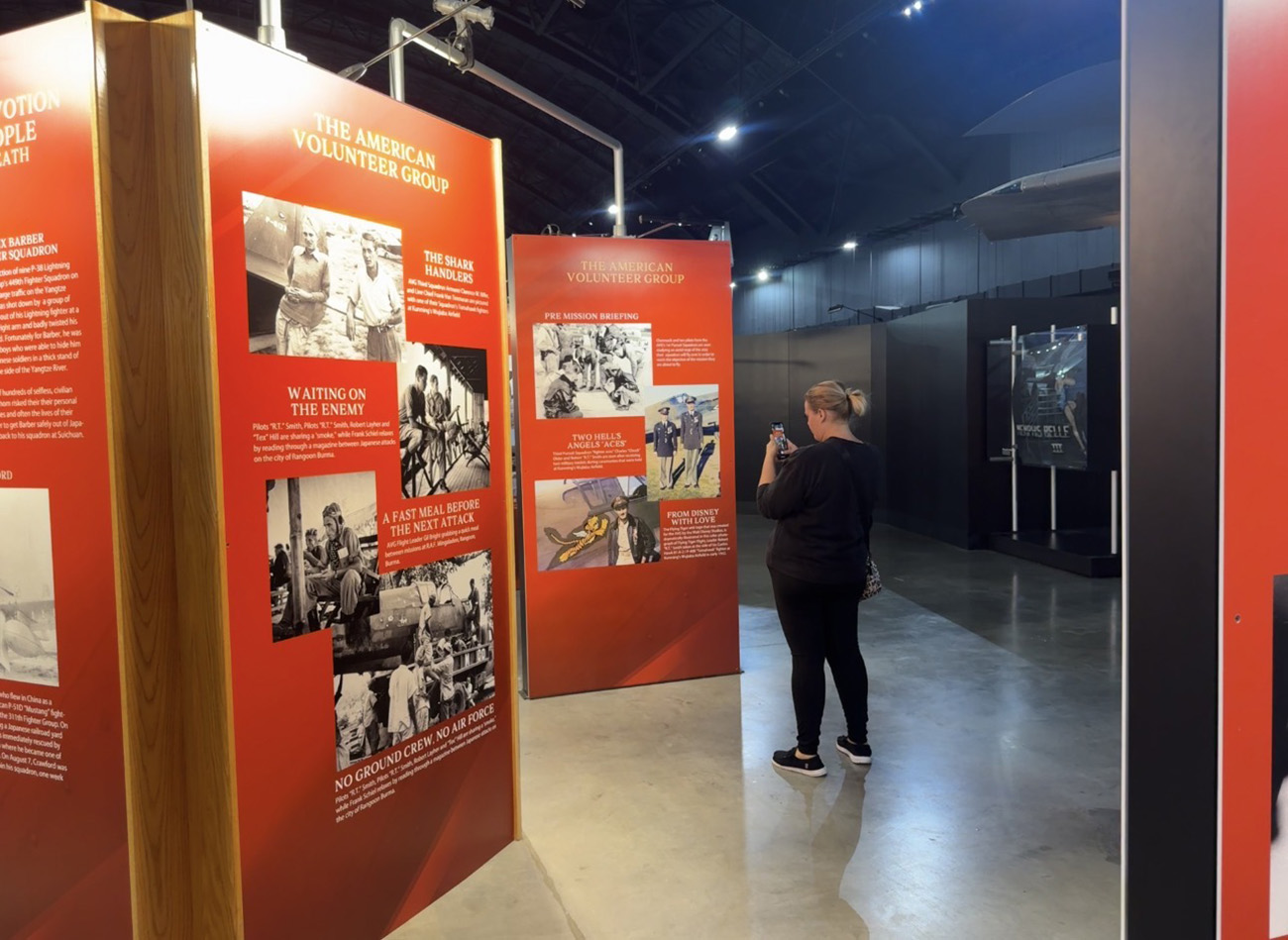Descendants of legendary pilots and Chinese civilians tell stories of courage, sacrifice and friendship

Editor's note: As April 18 marked the 82nd anniversary of the Doolittle Shangrao Rescue Operation, China Daily delves into the rich history of China-US friendship forged during World War II, capturing the personal experiences of those who served, their families and the Chinese civilians who risked their lives to help them.
"Just off the coast of California," Edward Stiles Jr's father told his mother where he was going before their marriage, but the real story was that his father was heading to China to fight against the Japanese invasion.
His father, Edward Stiles, was one of the first 27 men who joined the American Volunteer Group, nicknamed the Flying Tigers, and arrived in Toungoo, Burma, in 1941, serving as crew chief of the third squadron of the group.
"My father told me that being a part of the Flying Tigers was a great part of his life," Stiles told China Daily, saying his father had often talked to him about his going to China, saying it was an adventure because he and the squadron had to fake visas to enter China.
READ MORE: Century-long China ties still going strong
"The more I learned about my dad's time, the more I found out about the importance of what he did because it was important (not only) to Chinese people, but also to the United States at that particular time. It showed Americans were really fighting back."
When people fight in a common cause they can work together and help each other, and today the two countries can still work together on common goals, he said.
Traveling from Florida, he attended the Flying Tigers and Doolittle Raiders photo exhibition in Dayton, Ohio, and the Fifth US-China Second World War Friendship Conference with his family and friends, including the nephew of the Flying Tiger fighter pilot Jack Newkirk.
In the photo exhibition at the National Museum of the US Air Force in Dayton, put together by the Sino-American Aviation Heritage Foundation and the museum, more than 40 panels and 150 photos provided by Flying Tigers' descendants are exhibited. It runs until October.
April 18 marked the 82nd anniversary of the Doolittle Raid by the US on Tokyo and the largest Japanese island, Honshu, in World War II. It was the first US air operation and retaliation to strike mainland Japan after the Pearl Harbor attack in December 1941.
The exhibition records the story of how the Flying Tigers helped Chinese people fight the Japanese invaders together, and demonstrates how Chinese people rescued and saved US pilots.

The exhibition, representing people-to-people friendship between Chinese and US people more than 80 years ago, also attracts people who care about the relationship and want to extend the friendship from generation to generation to evoke memories to tell their story or their families' stories.
"I was born three weeks after my father arrived in the China Burma India Theater to begin training Chinese mechanics on how to work on the American B-25 airplanes," said Margaret Mills Kincannon, daughter of James Mills, a B-25 bomber crew chief of the Flying Tigers.
"He was away for all that time, and so I didn't get to be with him when I was a child until I was old enough to walk when he came home for Thanksgiving.
"He didn't tell me much about the war, but he told me about some friends of his who were also mechanics he worked with."
Kincannon said she was highly impressed when she heard her father pronounce some of his Chinese friends' names.
"He remembered their names 70 years later, and he also remembered some of the words and phrases that they taught him in Chinese.
"He said that he was able to go into villages and bargain with the shopkeepers and buy things. So he sent home a beautiful silk cape, a child's cape, when I was just a little girl, and it had beautiful, embroidered flowers, butterflies and birds. I still have that."
Serving in the Flying Tigers, her father taught the Chinese how to work on US aircraft, including using equipment, operating the plane properly and firing their guns.
"It was a joint effort. They worked together as brothers, they worked side by side, and they had this sense of family that developed between them.
"The Flying Tiger spirit is about overcoming hardships, overcoming disagreements, continuing to work together, cooperating and building a good relationship. And striving toward a common goal is what they did back during World War II."
Her father's generation did that 80 years ago, and "so could people today- pass the spirit of the Flying Tigers to promote the current relationship between China and the US", she said.
Her father passed on the indomitable spirit of the Flying Tigers to her. She continues to pass on this legacy through her writing, preserving the history and memories of that era. Her book The Spray and Pray Squadron identifies 120 men who served with her father in the same bomb squadron, and she contacted their families."I just feel that I must continue that legacy that he established," she said.
Kincannon visited China in October and some of the cities where her father was stationed or visited during the war.
"I was so grateful to be able to have that experience. I hope to be the one to preserve the history and pass on the Flying Tigers' spirit."
Carl Molesworth is also an author who specializes in World War II and has documented the story of the Flying Tigers.
His book Sharks Over China tells the story of the US Army Air Corps unit that continued the fight in China when General Claire Lee Chennault's Flying Tigers disbanded.

Genuine willingness
"It was a complicated time, a different time than now because China was being invaded by Japan, and people in the United States were upset about that, but they didn't know exactly what to do about it short of declaring war on Japan," Molesworth said. "But a certain number of pilots were willing to leave the American armed forces and go to China to fly in defense of China."
He told of young men who went to China to support the Chinese against Japanese aggression.
"Bill Reed, for example, joined the original Flying Tigers and even rejoined the US Army Air Force and came back to China again. Unfortunately, he was killed In December 1944."
Reed was a fighter pilot with nine confirmed aerial shootdowns, but died in defense of both countries he loved, Molesworth said, and during that time so many young men like Reed went to China, and returned to China to fight with Chinese soldiers and never made it back.
More than 2,000 Flying Tigers' airmen devoted their lives to the war. Thousands of stories of the Flying Tigers are waiting to be told, and people today are exploring their history, turning a name into a vivid story and retelling that Chinese and US pilots were working together, working across the Burma Road or hanging out in villages in Yunnan province, Molesworth said.
"It wasn't just the Doolittle Raiders, because all of the American pilots who were in China were subject to getting brought down behind enemy lines, and many of them were helped back to safety by Chinese civilians in the villages where they came down.
"The spirit of the Flying Tigers can help the two countries become closer, and we are at a beginning stage right now.
"The more of that the better the two countries are connected and know about each other and the better that has to be for everyone."
Chinese civilians provided US pilots with assistance at all costs, as more than 200 pilots of the Flying Tigers in distress were rescued by Chinese people.
Zhu Hongyou, director of Beijing New Fourth Army Research, said his father was one of the Chinese who helped US pilots.
In 1944, after carrying out the bombing of Hachiman iron and steel plant in Japan, a B-29 heavy bomber of the US 20th Air Force crashed into a lake in northern Jiangsu province, and the pilots, including Lieutenant Colonel Savoy, parachuted. The crash was on the edge of his father's base, and to rescue those pilots took a direct fight between the third division of the army and the Japanese army.
Hiding the pilots under raincoats and covering their faces with makeup, Chinese civilians and the army managed to get the pilots to safety.
"We all know they were here to help and we must treat them as guests," Zhu said. "That was a valuable friendship during wartime that people should never forget."
Jeffery Greene, chairman of the Sino-American Aviation Heritage Foundation, said: "Chinese people and American people fought, flew together, supporting each other and dying for each other. Americans and Chinese are indeed good friends."
Younger generations
Greene and his foundation have worked for 30 years to explore the stories of the Flying Tigers and have established the Flying Tigers Friendship School Program to promote communication between younger generations.
"American people don't know much about that history. Chinese people do not know the entire story either. But we intend to co-unite the Flying Tigers' legacy."
The Flying Tigers Friendship School Program allows US teenagers to travel to China for two weeks, exploring the country, especially airfields at which their ancestors had fought, and also the Flying Tigers Museum in China. Chinese students travel to the US to see NASA in Florida and NBA games, he said.
The program has more than 20 schools in China and the US, he said. Recently two schools in Yunnan province joined the program and will connect with schools in Texas.
Two students of a middle school in Zhijiang Dong autonomous county, Huaihua city, Hunan province, traveled to Dayton to take part in the exhibition and conference.
"We had learned a lot from General Chennault and his Flying Tigers," Shu Zihan, 15, said. "Fighting bravely and uniting in friendship is the spirit of the Flying Tigers, and we hope the spirit and such friendship can endure."
Zhang Zhixiang, also 15, said, "They contributed a lot in the victory of the Chinese people's War of Resistance against Japanese Aggression."
Zhang said he is excited to explore the US. Learning the history of the Flying Tigers at his school was inspiring, and seeing all the pictures of the US was touching, he said.
ALSO READ: Spirit of Flying Tigers essential for sound China-US relations
School officials and delegations from many provinces are in talks with principals of Flying Tigers Friendship Schools in California, Iowa, Texas and other states to explore the opportunity to sign a memorandum of cooperation and launch the second round of pairing of a school program.
Both China and the US are working to promote people-to-people communication, especially after the presidents of the two countries reached the San Francisco Vision in November.
"It is a great opportunity for kids from both countries to learn about the history and culture," Erik Lutz, mayor of Pico Rivera in Los Angeles County, said. He is exploring pairing with a sister school program in his city to promote communication between young people, he said.
Now it is important for future generations to appreciate each other, so the countries can then learn to collaborate on future projects, he said.


